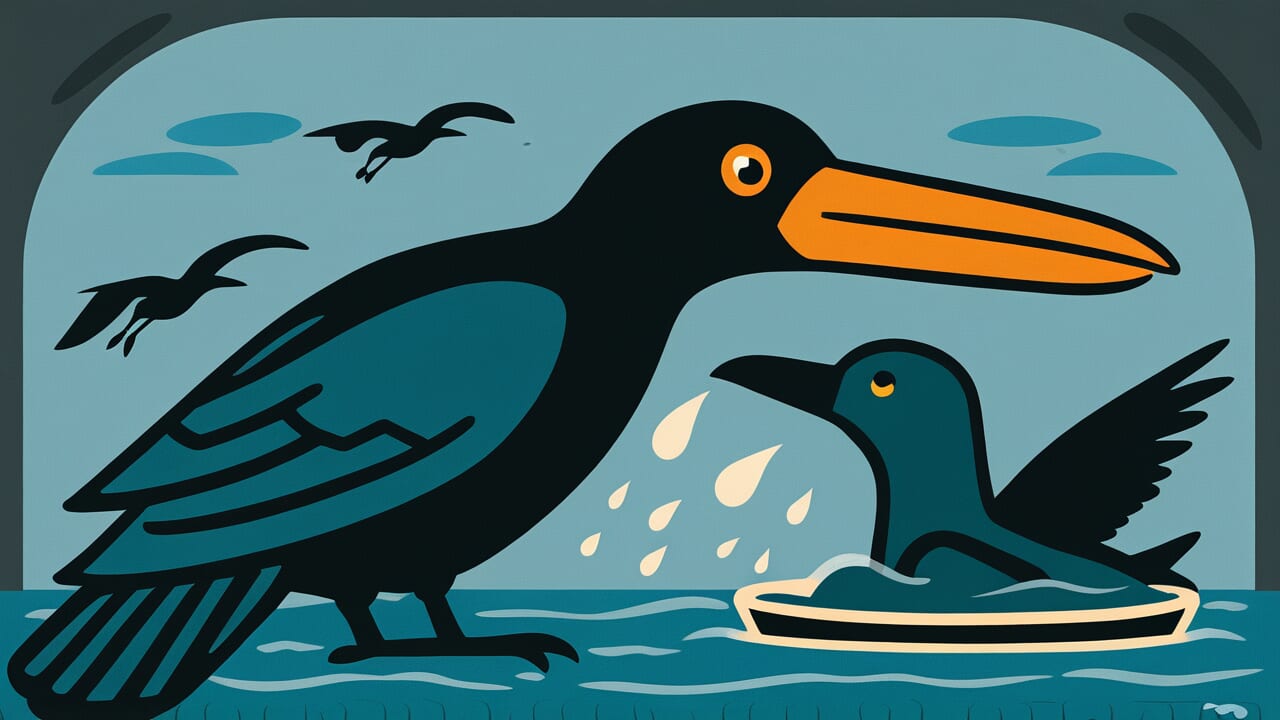How to Read “Use a crow as a cormorant”
Karasu wa u ni tsukau
Meaning of “Use a crow as a cormorant”
“Use a crow as a cormorant” describes someone who gains benefits by exploiting others’ superior abilities, even though they lack special skills or talents themselves.
It refers to situations where people accomplish things they couldn’t do alone by borrowing others’ abilities, then claim the results as their own.
This proverb carries a critical tone. It warns against people who don’t make their own efforts but depend on others’ talents and labor to steal the credit.
In business, it applies when bosses take credit for their subordinates’ achievements. It also describes people who present others’ ideas as their own.
Today, another expression meaning the same thing is more common in Japanese. But “Use a crow as a cormorant” still lives on as a critical phrase.
It describes the attitude of trying to succeed not through your own abilities, but by relying on others’ resources and skills.
Origin and Etymology
No clear written records explain the origin of this proverb. However, we can make interesting observations from how the words are structured.
The contrast between two types of water birds, the crow and the cormorant, forms the heart of this proverb.
Have you heard of cormorant fishing? It’s a traditional fishing method where fishermen tie strings around cormorants’ necks and make them catch fish.
Cormorants have excellent diving abilities and fish-catching skills. But humans exploit these abilities for their own benefit.
Crows, on the other hand, don’t have such specialized fishing abilities. Yet in this proverb, the crow stands on the side that uses the cormorant.
This creates a reversed structure. A crow with no abilities uses a cormorant with superior skills to gain benefits.
The cleverness of this contrast makes the proverb interesting.
Cormorant fishing has been practiced in Japan since ancient times. People saw this scene regularly in their daily lives.
The structure where capable beings are used while incapable ones gain the results likely drew inspiration from cormorant fishing scenes.
By deliberately choosing the crow, a bird unrelated to cormorant fishing, as the subject, the expression emphasizes the lack of ability even more strongly.
Usage Examples
- He never plans anything himself but gets praised by using his subordinates’ ideas. It’s exactly “Use a crow as a cormorant.”
- That company outsources all technology development. They just profit by “Use a crow as a cormorant.”
Universal Wisdom
The proverb “Use a crow as a cormorant” sharply points to a universal reality in human society: the imbalance of power.
Why can those without ability stand on the side that uses those with ability? This reveals an essential truth about human society.
Ability and power don’t necessarily align.
Looking back at history, countless examples show skilled technicians and artists being used by rulers who didn’t understand their talents.
Capable people often immerse themselves so deeply in their specialties that they become poor at political maneuvering and positioning.
Meanwhile, even those without special talents can convert others’ abilities into their own benefits if they know how to use people and grasp power.
This proverb has been passed down for so long because this structure is too universal.
Everyone must have felt the unfairness of having their efforts exploited by others. At the same time, it makes us aware that we might unknowingly depend on others’ power.
Our ancestors saw through the reality that ability and rewards aren’t always distributed fairly.
By leaving words that criticize this unfairness, they question us about the right way to be.
When AI Hears This
Crows and cormorants both eat fish, but ecologically they have completely different foraging systems.
Cormorants are diving foragers that pursue fish underwater. They have heavy skeletons and low feather water resistance.
Crows are opportunistic foragers that can only catch fish near the water surface. Both overlap in “eating fish,” but actually occupy different ecological niches.
According to ecology’s competitive exclusion principle, two species using the same resource in the same way cannot coexist. One must be eliminated.
But in nature, countless examples show seemingly similar organisms coexisting through subtle differences. Cormorants and crows are typical examples.
Their foraging depths, foraging times, and required fish sizes all differ.
What makes this proverb interesting is that it expresses human misperception. People see only the superficial similarity of “both are black birds that catch fish” and try to make crows do cormorants’ work.
This unconsciously captures an important principle in biodiversity. External similarity doesn’t mean functional identity.
The same mistake happens in modern personnel placement. All sales positions may look the same, but new customer development and existing customer cultivation require completely different abilities.
Placing people based only on superficial job classifications creates the same inefficiency as disturbing ecosystem order.
Lessons for Today
This proverb teaches us two important things for living in modern times.
First is a warning against depending too much on others’ power. It may seem easy in the short term.
But if you don’t polish your own abilities, no one will trust you in the long term.
When you accomplish something, is it truly through your own power? This question should motivate self-growth.
Second is having the eye to judge whether your abilities are being fairly evaluated.
If you have excellent abilities but someone is just exploiting you, you need courage to reconsider that relationship.
Knowing your own value and seeking appropriate rewards and recognition is never arrogant.
At the same time, this proverb makes us think about healthy cooperative relationships.
When working in teams, recognize each other’s contributions and share results fairly. Such obvious things are actually the most difficult and most important.
Are you someone’s crow? And are you making someone your cormorant?
This self-questioning becomes the first step toward building more honest human relationships.



Comments